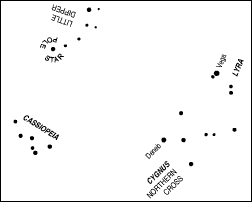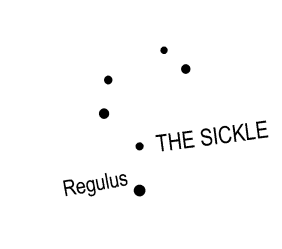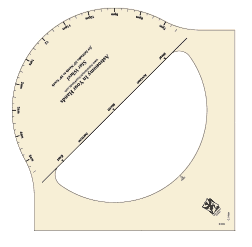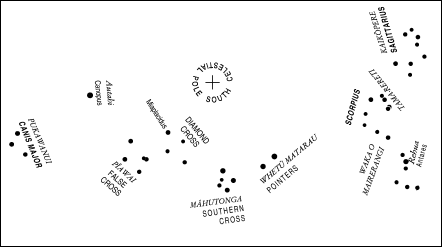|
|
Wheel
City Wheel
 
Milky Way Wheel
 
|
|
|
||||||||||||||||||||||||||||||||||||||||||||||||||
|
For latitudes |
Use the pocket for |
And the wheel for |
|
50° N to 60° N |
London, UK |
Los Angeles, California |
|
40° N to 50° N |
New York, NY |
|
|
30° N to 40° N |
Los Angeles, California |
|
|
20° N to 30° N |
Miami, Florida |
|
|
10° N to 20° N |
Manila, Philipines |
|
|
10° N to 10° S |
Quito, Equador |
|
|
10° S to 20° S |
Cairns, Australia |
Sydney, Australia |
|
20° S to 30° S |
Brisbane, Australia |
|
|
30° S to 40° S |
Sydney, Australia |
|
|
40° S to 50° S |
Hobart, Australia |
- When you have both Northern Hemisphere and Southern Hemisphere Star Wheels, be very careful to get the correct wheel in the pocket. The wheels are labelled with their hemisphere in the outer ring on the back. Check before you go outside – it’s quite easy to get the wheels mixed up and very confusing if you do. Note that the 10° N to 10° S pocket uses the Northern Hemisphere wheel.
 Science Background Knowledge
Science Background Knowledge
What Shape is the Sky?
- When you look at the blue sky during the day, what shape do you see? Our eyes cannot tell how far away the sky is, so our brains decide that it is all the same distance. This makes it look like the inside of a dome, ball or sphere.
- When you look at the sky on a clear night, what shape do you see? Although the stars are all different distances away, our eyes cannot tell this. They all look the same distance to us. So the night sky looks like the inside of a dome, ball or sphere.
- There are stars in all directions from the Earth, although we cannot see them all at once. So we think of the stars as forming a starry sphere, known as the celestial sphere.
- How much of this starry sphere can we see at any one time? We can only see half of it. The half that we can see is called the sky.
- In a Star Wheel, the wheel is a map of the entire celestial sphere, and the window shows us the part we can actually see at any one time; the sky.
The Shape of a Double-sided Star Wheel
- The wheel is a double-sided map showing the starry sphere (celestial sphere). When we take a sphere and make a flat map of it, we have to stretch it. The stretching is especially noticeable around the edges of the map. We cannot put the whole sphere on a single map, as it would be stretched beyond recognition at the edges. For this reason we use two maps, one on each side of the wheel. Each covers about three-quarters of the sphere.
- It is not possible to fit the whole sky into one window, so it is split into two. The two windows have a significant amount of overlap. Taken together the two windows represent the part of the sky that we can see at one time: half of a sphere. The horizon is a line running around the edge of the sky, so the horizon line runs around the edges of the windows.
- In reality the horizon is circular, but this is distorted by the stretching involved in making a flat map. This explains the unusual shapes of the windows, and why east and west are not exactly opposite each other on the windows’ edges.
- When you put the wheel in the pocket, the windows show the stars visible in that part of the sky at that particular time.
The Shape of a Single-sided Star Wheel
- The wheel is a map of the stars. It shows a part of the starry sphere (celestial sphere). When we take a sphere and make a flat map of it, we have to stretch it. The stretching is especially noticeable around the edges of the map. We cannot put the whole sphere on the map, as it would be stretched beyond recognition at the edges. For this reason the wheel covers about three-quarters of the sphere.
- The window represents the sky that we can see at one time: half of a sphere. The horizon is a line running around the edge of the sky, so the horizon runs around the edge of the window. The middle of the window is the part of the sky directly overhead.
- In reality the horizon is circular, but this is distorted by the stretching involved in making a flat map. This is why the window looks like a squashed circle, and why east and west are not exactly opposite each other on the window.
- When you put the wheel in the pocket, the window shows the stars visible in the sky at that particular time.
Distortion at the Edges
 The City Wheel has been stretched unevenly to preserve
the shapes of individual constellations at the expense of
the spaces between them. This is of great benefit to
beginner stargazers as the constellations are shown in the
correct part of the sky and the same shape as they appear in
the sky.
The City Wheel has been stretched unevenly to preserve
the shapes of individual constellations at the expense of
the spaces between them. This is of great benefit to
beginner stargazers as the constellations are shown in the
correct part of the sky and the same shape as they appear in
the sky.
- On the right is the actual shape of the Sickle of Leo as it appears on the City wheel. This is exactly as it appears in the sky. (In the Southern Hemishpere it will appear the other way up, but still the same shape.)

This technique cannot be used for the Milky Way Wheel. The Milky Way wheel shows so many stars that there are not enough empty spaces to adjust in this way. Without adjustment the constellations furthest from the centre look squashed.
- The illustration on the right shows the Sickle of Leo when it is close to the centre of the Milky Way wheel. It is very little different from its actual appearance in the sky.

However, when it is close to the edge of the wheel, as shown here, you can see that it looks quite a different shape to the actual shape in the sky.
- If you are looking for a constellation that can be seen in both the front and back windows, it is best to use the window in which it can be seen closer to the centre of the wheel.
|
|
URL http://www.AstronomyInYourHands.com/starwheel/starwheel.html This page modified 6 Nov 2002





